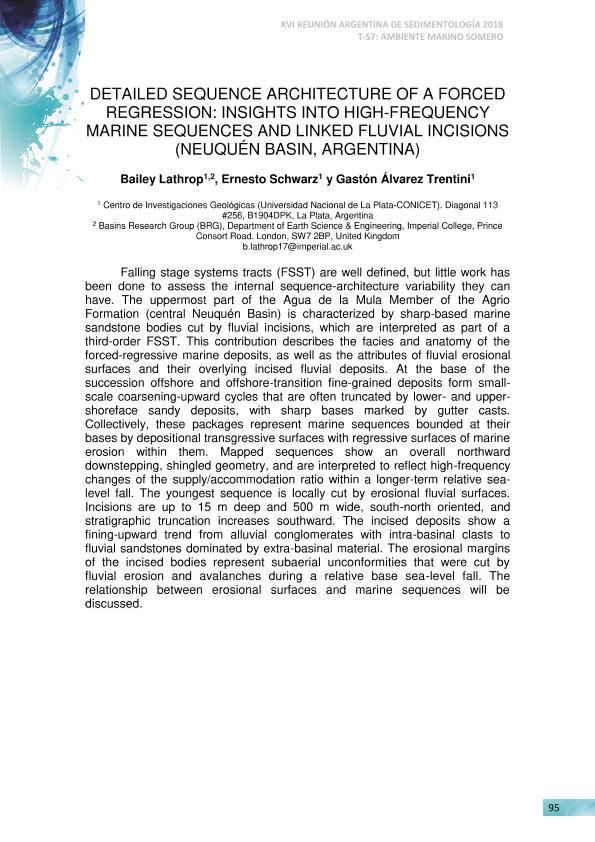Mostrar el registro sencillo del ítem
dc.contributor.author
Lathrop, Bailey
dc.contributor.author
Schwarz, Ernesto

dc.contributor.author
Álvarez Trentini, Gastón

dc.contributor.other
Báez, Alejandro David

dc.contributor.other
Gómez, Ricardo
dc.date.available
2023-07-26T15:43:35Z
dc.date.issued
2018
dc.identifier.citation
Detailed sequence architecture of a forced regression: Insights into high-frequency marine sequences and linked fluvial incisions (Neuquén basin, Argentina); XVI Reunión Argentina de Sedimentología; General Roca; Argentina; 2018; 95-95
dc.identifier.uri
http://hdl.handle.net/11336/205618
dc.description.abstract
Falling stage systems tracts (FSST) are well defined, but little work has been done to assess the internal sequence-architecture variability they can have. The uppermost part of the Agua de la Mula Member of the Agrio Formation (central Neuquén Basin) is characterized by sharp-based marine sandstone bodies cut by fluvial incisions, which are interpreted as part of a third-order FSST. This contribution describes the facies and anatomy of the forced-regressive marine deposits, as well as the attributes of fluvial erosional surfaces and their overlying incised fluvial deposits. At the base of the succession offshore and offshore-transition fine-grained deposits form smallscale coarsening-upward cycles that are often truncated by lower- and uppershoreface sandy deposits, with sharp bases marked by gutter casts. Collectively, these packages represent marine sequences bounded at their bases by depositional transgressive surfaces with regressive surfaces of marine erosion within them. Mapped sequences show an overall northward downstepping, shingled geometry, and are interpreted to reflect high-frequency changes of the supply/accommodation ratio within a longer-term relative sealevel fall. The youngest sequence is locally cut by erosional fluvial surfaces. Incisions are up to 15 m deep and 500 m wide, south-north oriented, and stratigraphic truncation increases southward. The incised deposits show a fining-upward trend from alluvial conglomerates with intra-basinal clasts to fluvial sandstones dominated by extra-basinal material. The erosional margins of the incised bodies represent subaerial unconformities that were cut by fluvial erosion and avalanches during a relative base sea-level fall. The relationship between erosional surfaces and marine sequences will be discussed.
dc.format
application/pdf
dc.language.iso
spa
dc.publisher
Asociación Argentina de Sedimentología
dc.rights
info:eu-repo/semantics/openAccess
dc.rights.uri
https://creativecommons.org/licenses/by-nc-sa/2.5/ar/
dc.subject
FORCED REGRESSION
dc.subject
SEQUENCE ARCHITECTURE
dc.subject
FLUVIAL INCISIONS
dc.subject
NEUQUÉN BASIN
dc.subject.classification
Geología

dc.subject.classification
Ciencias de la Tierra y relacionadas con el Medio Ambiente

dc.subject.classification
CIENCIAS NATURALES Y EXACTAS

dc.title
Detailed sequence architecture of a forced regression: Insights into high-frequency marine sequences and linked fluvial incisions (Neuquén basin, Argentina)
dc.type
info:eu-repo/semantics/publishedVersion
dc.type
info:eu-repo/semantics/conferenceObject
dc.type
info:ar-repo/semantics/documento de conferencia
dc.date.updated
2023-02-06T13:53:29Z
dc.journal.pagination
95-95
dc.journal.pais
Argentina

dc.journal.ciudad
General Roca
dc.description.fil
Fil: Lathrop, Bailey. Consejo Nacional de Investigaciones Científicas y Técnicas. Centro Científico Tecnológico Conicet - La Plata. Centro de Investigaciones Geológicas. Universidad Nacional de La Plata. Facultad de Ciencias Naturales y Museo. Centro de Investigaciones Geológicas; Argentina. Imperial College London; Reino Unido
dc.description.fil
Fil: Schwarz, Ernesto. Consejo Nacional de Investigaciones Científicas y Técnicas. Centro Científico Tecnológico Conicet - La Plata. Centro de Investigaciones Geológicas. Universidad Nacional de La Plata. Facultad de Ciencias Naturales y Museo. Centro de Investigaciones Geológicas; Argentina
dc.description.fil
Fil: Álvarez Trentini, Gastón. Consejo Nacional de Investigaciones Científicas y Técnicas. Centro Científico Tecnológico Conicet - La Plata. Centro de Investigaciones Geológicas. Universidad Nacional de La Plata. Facultad de Ciencias Naturales y Museo. Centro de Investigaciones Geológicas; Argentina
dc.relation.alternativeid
info:eu-repo/semantics/altIdentifier/url/https://sedimentologia.org.ar/ras/XVIRAS.pdf
dc.relation.alternativeid
info:eu-repo/semantics/altIdentifier/url/https://www.sedimentologia.org.ar/spa/ras/
dc.conicet.rol
Autor

dc.conicet.rol
Autor

dc.conicet.rol
Autor

dc.coverage
Nacional
dc.type.subtype
Reunión
dc.description.nombreEvento
XVI Reunión Argentina de Sedimentología
dc.date.evento
2018-11-26
dc.description.ciudadEvento
General Roca
dc.description.paisEvento
Argentina

dc.type.publicacion
Book
dc.description.institucionOrganizadora
Asociación Argentina de Sedimentologia
dc.description.institucionOrganizadora
Universidad Nacional de Río Negro
dc.source.libro
Libro de Resúmenes de la XVI Reunión Argentina de Sedimentología: Sedimentología Sin Frontera
dc.date.eventoHasta
2018-11-30
dc.type
Reunión
Archivos asociados
